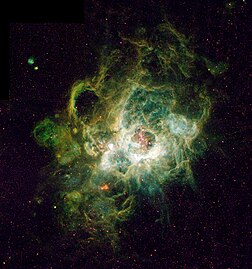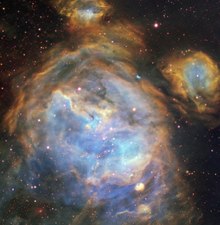H II region
An H II region is a region where huge blue stars are formed from hydrogen. They are named after the ionised atomic hydrogen which they produce: H II.[2]



The stars form inside a large cloud of hydrogen gas. The short-lived blue stars formed in these regions give off huge amounts of ultraviolet light. This ionizes the surrounding gas.
H II regions can be several hundred light-years across. The first known H II region was the Orion nebula, which was discovered in 1610.[3] These regions have extremely varied shapes. They often appear clumpy and filamentary, sometimes showing bizarre shapes such as the Horsehead nebula.
H II regions give birth to thousands of stars over several million years. Eventually, this produces a star cluster. In the end, supernova explosions and strong stellar winds from the most massive stars blow away the gases of the H II region. This leaves behind behind a cluster of stars such as the Pleiades.[4]
H II regions can be seen at huge distances in the universe.The study of extragalactic H II regions helps to fix the distance and chemical composition of other galaxies.
Spiral and irregular galaxies have many H II regions, while elliptical galaxies have almost none. In spiral galaxies, like the Milky Way, H II regions are found in the spiral arms, but in the irregular galaxies they are distributed at random.
Some galaxies have huge H II regions, with tens of thousands of stars. Examples include the 30 Doradus region in the Large Magellanic Cloud and NGC 604 in the Triangulum galaxy.
References
change- ↑ "Bubbles of Brand New Stars". www.eso.org. Retrieved 8 February 2019.
- ↑ Pronounced H-two by astronomers (an H I region is neutral atomic hydrogen, and H2 is molecular hydrogen)
- ↑ Harrison T.G. 1984. The Orion nebula – where in history is it? Quarterly Journal of the Royal Astronomical Society 25: 65–79.
- ↑ Anderson L.D.; et al. (2009). "The molecular properties of galactic HII regions". The Astrophysical Journal Supplement Series. 181 (1): 255–271. arXiv:0810.3685. Bibcode:2009ApJS..181..255A. doi:10.1088/0067-0049/181/1/255. S2CID 10641857.